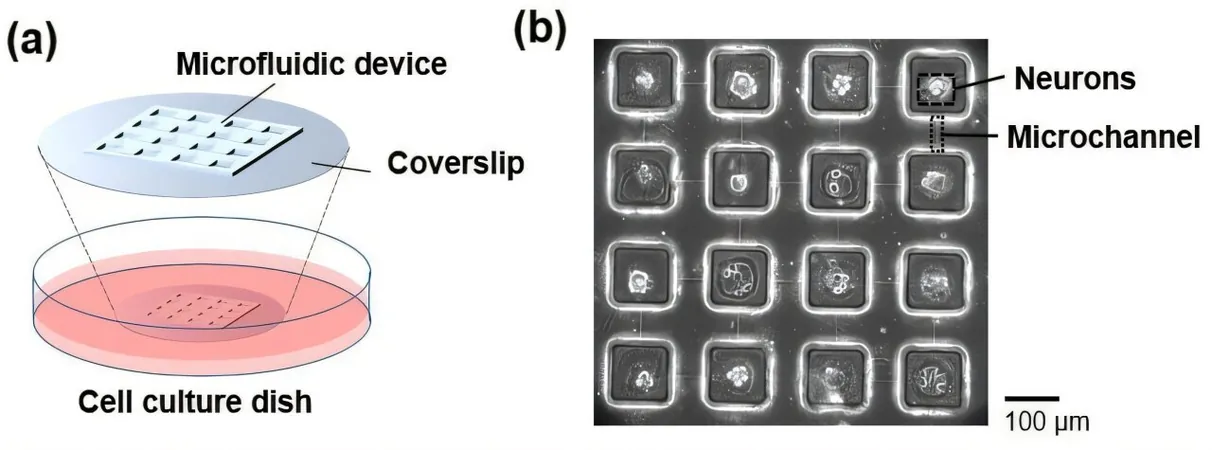
Breakthrough in Lab-Grown Neuronal Networks: A Leap Towards Understanding Brain Plasticity
2024-12-16
Author: Charlotte
Introduction
In the world of neuroscience, the saying "neurons that fire together, wire together" captures the essence of neural plasticity inherent to our brains. However, traditional methods of culturing neurons in a dish have often failed to mimic this crucial principle. Instead of forming meaningful connections, these cultured neurons typically create random networks that do not reflect how real brains learn or adapt. But what if we could engineer in-vitro neurons that truly embody the natural behaviors of their in vivo counterparts?
Pioneering Research
A pioneering research team from Tohoku University has taken a monumental stride in this direction by utilizing advanced microfluidic devices. These innovative devices allow for the reconstitution of biological neuronal networks that exhibit connectivity patterns resembling those found in actual animal nervous systems. Their latest findings reveal that these engineered networks display intricate activity patterns capable of being dynamically altered through repetitive stimulation. This groundbreaking study opens new avenues for understanding the mechanisms of learning and memory.
The Study
The study was published in *Advanced Materials Technologies* on November 23, 2024, and it highlights a significant shift in the approach to studying neural networks. In specific areas of the brain, information is organized and stored through “neuronal ensembles”—cooperative groups of neurons that activate simultaneously in response to stimuli. The adaptability of these ensembles is believed to underpin the brain's learning and memory processes. However, investigating these complex functions in traditional animal models presents significant challenges due to their intricate biological structures.
Controlled Laboratory Settings
Hideaki Yamamoto from Tohoku University emphasizes the necessity of growing neurons in controlled laboratory settings: “Lab-grown neurons enable scientists to probe the workings of learning and memory under highly regulated conditions. The desire for these neurons to closely mimic real brain activity is essential for progress in neuroscience.”
Microfluidic Device Innovation
The researchers ingeniously created a specialized model using a microfluidic device—a tiny chip containing complex 3D architecture. This device facilitates neuronal connections that parallel those in animal nervous systems. The size and shape of the tiny channels (known as microchannels) were carefully manipulated to influence the strength of neuronal interactions.
Diverse Neuronal Ensembles
Notably, the study revealed that networks formed within smaller microchannels maintained diverse neuronal ensembles. While conventional neuron cultures typically displayed a single ensemble, those cultivated in smaller microchannels showed the capacity to host up to six distinct ensembles. Moreover, the research demonstrated that repetitive stimulation could actively modulate these ensembles, evoking a process akin to neural plasticity where the neurons appeared to reorganize themselves.
Implications for Neurobiology
The implications of this microfluidic technology combined with in-vitro neurons are exciting and point towards the future of neurobiology. Researchers foresee the potential to develop sophisticated models that replicate specific brain functions, such as the intricacies of memory formation and recall.
Conclusion
As we venture deeper into the realms of neuroscience, this breakthrough brings us closer to understanding the enigma of the human brain and its capacity for adaptation. Could this be the moment that transforms how we approach neurological disorders, learning disabilities, or even artificial intelligence? The possibilities are endless!









 Brasil (PT)
Brasil (PT)
 Canada (EN)
Canada (EN)
 Chile (ES)
Chile (ES)
 España (ES)
España (ES)
 France (FR)
France (FR)
 Hong Kong (EN)
Hong Kong (EN)
 Italia (IT)
Italia (IT)
 日本 (JA)
日本 (JA)
 Magyarország (HU)
Magyarország (HU)
 Norge (NO)
Norge (NO)
 Polska (PL)
Polska (PL)
 Schweiz (DE)
Schweiz (DE)
 Singapore (EN)
Singapore (EN)
 Sverige (SV)
Sverige (SV)
 Suomi (FI)
Suomi (FI)
 Türkiye (TR)
Türkiye (TR)